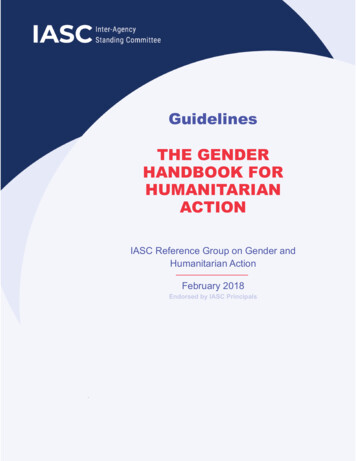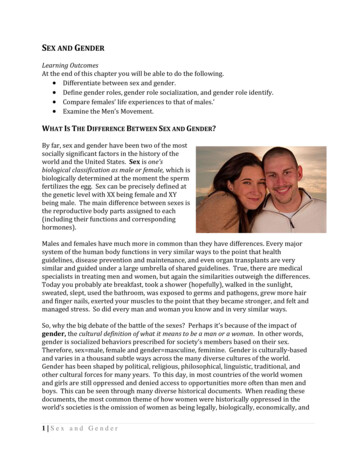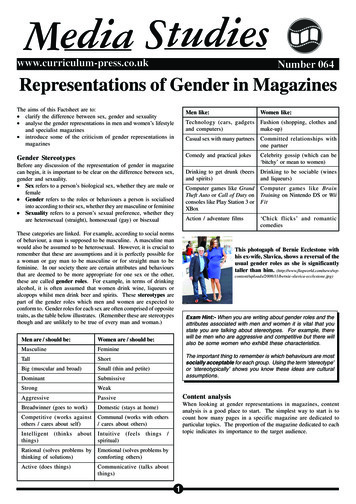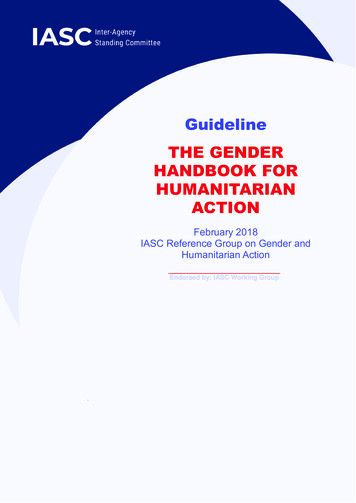
Transcription
GuidelinesTHE GENDERHANDBOOK FORHUMANITARIANACTIONIASC Reference Group on Gender andHumanitarian ActionFebruary 2018Endorsed by IASC Principals
for Humanitarian ActionThe Gender HandbookTheGenderHandbookfor Humanitarian ActionIASCIASCInter-AgencyStanding CommitteeIASCInter-AgencyStanding CommitteeInter-AgencyStanding CommitteeInter-AgencyStanding CommitteeReference Group for Gender in Humanitarian ActionIASCInter-AgencyStanding Committee
M''''''''''''''''':''''II''''''' ''''''''''
TheGenderHandbookfor Humanitarian ActionIASCInter-AgencyStanding CommitteeInter-AgencyStanding Committee
Copyright Inter-Agency Standing Committee (IASC) 2017. All rights reserved.This document is issued for general distribution. Reproductions and translations are authorized,except for commercial purposes, provided the source is acknowledged.Alternative language versions of this IASC Gender Handbook for Humanitarian Action can be obtained atthe IASC gender website: d-humanitarian-action.Agencies have the right to translate the handbook to other languages provided the IASC is acknowledged.This website also offers further resources on gender in humanitarian action.IASCInter-AgencyStanding CommitteeIASCInter-AgencyStanding CommitteeReference Group for Gender in Humanitarian Action
The Gender Handbookfor Humanitarian ActionAll-new Second EditionThe Inter-Agency Standing Committee (IASC) published the original Women,Girls, Boys and Men. Different Needs — Equal Opportunities: Gender Handbookin Humanitarian Action in 2006. The purpose of the handbook was to providehumanitarian actors with guidance on gender analysis, planning and actions toensure that the needs, priorities and capacities of women, girls, men and boys areconsidered in all aspects of humanitarian response. The first edition predated themore recent humanitarian reform and Transformative Agenda processes and assuch, did not reflect the current iteration of the sector system, the IASC GenderMarker, the Humanitarian Programme Cycle and other advances in humanitariancoordination, leadership, accountability and partnership. After wide consultationswith IASC members, sector leaders, field users and donors, the Gender Handbookhas been updated. The revised version is a concise guide built upon lessons learnedby the humanitarian community and reflects the main challenges faced in ensuringthat gender is adequately integrated into humanitarian planning and programming.The handbook is complemented by detailed information found in the regularlyupdated online platform. The review of the handbook was undertaken by the IASCGender Reference Group in 2016. It was endorsed by the IASC to meet collectivecommitments on gender equality in humanitarian action.3
ForewordMonique Pariat, Director-General, Directorate-Generalfor European Civil Protection and Humanitarian AidOperations (ECHO), European Commission4
Natural and man-made crises have a different impact onwomen, girls, boys, men. The European Union is committedto ensuring that all its humanitarian aid operations integrategender and age, as a matter of quality and effectiveprogramming. I am therefore pleased that the EuropeanUnion, through its Directorate-General for European CivilProtection and Humanitarian Aid Operations (DG ECHO),has supported this timely revision of the 2006 versionof the Inter-Agency Standing Committee (IASC) GenderHandbook for Humanitarian Action.This Handbook usefully stresses that ensuring that allpeople affected by crisis are reached with a needs andcapacities-adapted response is a matter of quality andeffective programming, and is no longer a negotiablerequirement for humanitarian actors. Integratinggender considerations into humanitarian programmingcontributes to enhancing access to assistance. Byfostering meaningful participation of women, girls, menand boys, we can design our responses better. Affordingprotection to all groups in vulnerable situations mustbe a cornerstone of our efforts. We all need to do moreto prevent and mitigate protection risks and ensurethat adequate responses are provided. I hope that thisHandbook will become an international resource thatcontributes to this work.With the finalization of this review of the Handbook,humanitarian actors now have a comprehensive packageof guidance on gender mainstreaming and on addressingand preventing gender-based violence at their disposal:the IASC Gender Handbook, the IASC Guidelines forIntegrating Gender-based Violence Interventions inHumanitarian Action, as well as the upcoming revisedIASC Gender-Age Marker. I urge all humanitarianactors to make use of these important tools; theircomplementarity and interplay can make a significantcontribution to ensuring that the needs of women, girls,men and boys are taken into consideration at all stagesof humanitarian relief operations.Let me end by stressing that integrating gender inhumanitarian action is a shared responsibility. It isa responsibility for all humanitarian aid workers, nomatter what sector they work on. It is my hope thatthis Handbook, which provides practical guidanceon integrating gender into 11 sectors, will help fulfilthis responsibility.Monique Pariat5
ForewordMark Lowcock, Under-Secretary-General forHumanitarian Affairs and Emergency Relief Coordinator6
Around the world, armed conflicts and natural disasters areexacting a massive toll on the lives of millions of people. Ineach and every one of these humanitarian crises, we knowthat women and girls are affected differently than menand boys, and that vulnerabilities are often exacerbatedby other factors such as age, disability, sexual orientation,ethnicity or religion.Gender equality and the empowerment of women andgirls are at the very core of principled and effectivehumanitarian action. As humanitarians, it is ourfundamental responsibility to protect and promote therights of all people we serve. To this end, we need tounderstand the specific needs, capacities and prioritiesof women, girls, boys and men, and integrate thisunderstanding throughout the programme cycle. It alsomeans we must facilitate the active participation andleadership of women and girls in humanitarian action andbeyond; and promote transformative change for moreinclusive and equitable societies.On behalf of the Inter-Agency Standing Committee (IASC),I am pleased to present this updated version of the GenderHandbook in Humanitarian Action. It is an importantresource that will help humanitarian actors build on IASCcommitments on gender equality and women and girlsin humanitarian action, with the aim of delivering moreeffective, rights-based programming. The Handbook offerspractical guidance to ensure that gender equality andwomen’s empowerment are mainstreamed throughoutthe assessment, planning, resource mobilization,implementation and monitoring stages of the humanitarianprogramme cycle.On behalf of the IASC, I would like to extend ourappreciation to everyone involved, across manyorganisations, for their considerable investments in bothcapital and human resources towards the development ofthis new Gender Handbook for Humanitarian Action.As the humanitarian community moves forward in itsshared responsibility to leave no one behind, I am sure thisHandbook will be an instrumental resource for partnersaround the world.Mark Lowcock7
AcknowledgementsThe review of the 2006 versionof this handbook was initiated bythe IASC Gender Reference Groupand led by UN-Women and Oxfam,with substantive contributionsfrom a multi-stakeholderSteering Committee comprisingrepresentatives of CARE, GenCap,InterAction, OCHA, UNFPA,UNHCR, WFP, WRC and DG ECHOas an observer.This update of the handbook wassupported by funding from theEuropean Commission’s DirectorateGeneral for European Civil Protectionand Humanitarian Operations(ECHO), and with co-funding from theSwedish International DevelopmentCooperation Agency, Sida.88In a quest to make it practical and user-friendly, this revisededition of the IASC Gender Handbook benefits fromthe feedback of more than 250 stakeholders worldwideincluding: government entities; donors; United Nationsagencies and sectors; and international and national nongovernmental and civil society organizations, including theRed Cross movement. Additionally, technical contributionswere provided by members of the sector leadership systemof the IASC and a host of gender specialists.More specifically, the following agencies and organizationscontributed to the development of the IASC GenderHandbook. This updated version contributes to genderequality and women’s empowerment programming andoutcomes in humanitarian action around the world.
CAREDirectorate-General forEuropean Civil Protection andHumanitarian Aid OperationsFood and Agriculture OrganizationHelpAgeInteractionInter-Agency Standing CommitteeIASC GenCap ProjectInternational Committeeof the Red CrossInternational Federationof the Red Cross andRed Crescent SocietiesInternational Organizationfor MigrationInternational Rescue CommitteeNorwegian Refugee CouncilUnited Nations Officefor the Coordination ofHumanitarian AffairsOffice of the United Nations HighCommissioner for Human RightsOxfamSwedish InternationalDevelopment CooperationAgency (Sida)United Nations Children’s FundUnited Nations DevelopmentProgrammeOffice of the United Nations HighCommissioner for RefugeesUnited Nations Mine Action ServiceUnited Nations Population FundUnited Nations Entity forGender Equality and theEmpowerment of WomenWorld Food ProgrammeWorld Health OrganizationWomen’s Refugee Commission9
Contents4 Forewords8 Acknowledgements12 Introduction: How to use this handbookABPage 15Why gender equalityis essential tohumanitarian actionPage 27Integrating genderinto the HumanitarianProgramme Cycle30 Needs assessment and analysis44 Strategic planning54 Resource mobilization56 Implementation and monitoring60 Operational peer reviewand evaluation74 Checklist80 Key approaches10
CPage 93Gender equalityand specific sectors94 Cash-based interventions118 Camp coordinationand camp management146 Early recovery168 Education198 Food security222 Health248 Livelihoods276 Nutrition298 Protection324 Shelter350 Water, sanitation and d definitionsNormative frameworksEndnotes11
IntroductionHow touse thisHandbookHumanitarian action provides lifesaving services and facilitatesrecovery for communities affectedby armed conflict, natural disastersand other complex emergencies. Theresponsibility of humanitarian actors topromote gender equality is supportedby a normative framework validated byextensive field experience. 1This handbook sets out the rationalefor integrating gender equality intohumanitarian action and providespractical guidance for doing so acrosssectors. The main objective is tosupport humanitarian actors in reachingall people affected by crisis by:121.2.3.Ensuring that the specific needs, capacitiesand priorities of women, girls, men and boysare identified and that assistance targetsthe persons and groups most in need;Informing women, girls, men and boysof their entitlements and availableresources and engaging their participationand women’s leadership in programmedesign; andMonitoring and evaluating the impact of ourprogrammes and strategies on those weassist, including identifying and dismantlingbarriers and discrimination, including bypromoting and enabling women’s leadershipat the community level and in otherdecision-making processes.
The handbook is divided into the followingthree sections:PART A explains the basics of gender and why theintegration of gender equality and women’s empowermentis essential to effective, participatory and equitablehumanitarian protection and assistance.PART B explains how to integrate gender into the differentphases of a programme cycle, using the United Nations-ledhumanitarian coordination process — the HumanitarianProgramme Cycle (HPC) — as the working example.PART C provides specific guidance in 11 sectors: cashbased programming; camp coordination and campmanagement; early recovery; education; food security;health; livelihoods; nutrition; protection; shelter; and water,sanitation and hygiene (WASH). This section sets outthe key ways in which gender affects the outcomes ofspecific sectors and can be integrated across the HPC.The handbook provides practical guidance on developingsector-specific solutions using gender analysis. Given theimportance of cross-sectoral coordination, where possiblesector actors should review the content of all relevantsections and not just those that apply directly to theirsphere of operations.The target audience is front-line humanitarian actorsacross all sectors, including United Nations agencies, localand international non-governmental organizations (NGOs)and government agencies. The handbook is designedto be practical and concise for use in the field and is notexhaustive. It is designed to be used in conjunction withthe online platform www.gihahandbook.com. Here, userswill find detailed information and links to other guidancedocuments and platforms. The handbook is also intendedas a resource for gender specialists to support their work inintegrating gender equality into humanitarian settings.It is expected that the handbook will be used alongsideother resources for humanitarian actors such as theIASC ‘Guidelines for Integrating Gender-based ViolenceInterventions in Humanitarian Action’ (https://tinyurl.com/ycec8k6v), which includes sector-specific guidelines tocoordinate, plan, implement, monitor and evaluate essentialactions for the prevention and mitigation of gender-basedviolence (GBV) in humanitarian response as well as the‘SPHERE Handbook’ https://tinyurl.com/ybekpt6u) whichprovides a detailed discussion of the minimum standardsand key actions which need to be in place to ensure a lifewith dignity for the affected population with a focus on theareas of WASH, food security and nutrition, shelter and nonfood items (NFIs) and health action.This Gender Handbook for Humanitarian Action drawsupon many tools, guidance documents and other resourcesdeveloped by the United Nations, national and internationalNGOs and academic sources. Each sectoral chapterfeatures a list of resources specific to that area of concern.Normative framework for genderequality in humanitarian actionUNITED NATIONSSECURITY COUNCILRESOLUTIONSINTERNATIONALAND NATIONALLAWHUMANITARIANAND GENDERSTANDARDSAND GUIDELINES13
AWhy gender equalityis essential tohumanitarian action15
Effective, equitable and participatory humanitarian action cannot beachieved without understanding and responding to the specific needs,priorities and capacities of diverse women, girls, men and boys indifferent age groups (Box A1). Integrating gender equality also reinforcesa human rights-based approach to humanitarian action which improvesprogramming by respecting and protecting the universally recognizedrights and dignities of every individual as a human being. Incorporatinggender equality in humanitarian action therefore enhances the impact ofhumanitarian strategies and interventions. The answers to the questions,“what is gender?”, “what is gender equality?” and “why is it essential tohumanitarian action?” are explained below.16WHY GENDER EQUALITY IS ESSENTIAL TO HUMANITARIAN ACTION
BOX A1The handbook uses the shorter phrase “women, girls, men andboys” throughout to refer to women and men of: (a) different ages,understanding that gender roles and responsibilities change acrossthe life cycle; (b) diverse backgrounds, understanding that sexuality,ethnicity, nationality, disability, belief, civil or economic status, normsand cultural and traditional practices etc. can be barriers or enablers,depending on context; and (c) different experiences, understandingthat experiences of marginalization are heterogeneous.Marginalization derives from multiple and intersecting factors.What is “gender”?Gender is a social construct built through cultural, politicaland social practices that defines the roles of women, girls,men and boys, as well as the social definitions of what itmeans to be masculine and feminine. Gender roles aretaught, learned and absorbed and vary between andeven within cultures. Gender often defines the duties andresponsibilities expected of women, girls, men and boys atany given time of their lives and sets some of the barriersthey may face or opportunities and privileges they mayenjoy throughout their lives.Whilst gender is the primary focus of this handbook, aperson’s standing in any given society is also affected byother diversity factors such as disability, social class, race,caste, ethnic or religious background, nationality, language,economic wealth, level of education, marital status,displacement situation, sexual identity and urban/ruralsetting. (See annex 1 for all gender-related definitions.)Gender, along with age, sexual orientation and gender identity,determines the power which women, girls, men and boys haveand their ability to access and control resources. For instance,although international legal frameworks guarantee equal rightsto women and men, the lived experiences of women, girls,men and boys are different. In most contexts, men and boysplay gender roles which often hold more social, economic andpolitical power than those of women and girls. Consequently,men and boys exercise more decision-making power andautonomy over their own lives and over the decisions in theircommunities and families. Conversely, women and girls oftenlack the power to manage their own lives, including makingdecisions over their own bodies, marital status and havingaccess to social, economic or political resources.17
BOX A2In emergency settings,wheelchairs provided forpeople with disabilities aresometimes too heavy forwomen with disabilities touse independently. In thisscenario, factoring in thespecific challenges thatwomen with disabilitiesmay face by accounting fortheir needs is an example ofincorporating a gender lensin humanitarian action.Often, sexual and gender minorities experiencenegative consequences for not adopting gender rolesand characteristics assigned by society. Risks includediscrimination, prejudice and stigma, increased exposureto violence, difficulty accessing humanitarian services andbeing overlooked during consultation when the protectionand humanitarian needs of a crisis-affected populationare identified. Lesbian, gay, bisexual, transgender and/orintersex (LGBTI) individuals, for example, often face a widerange of challenges and threats in their everyday lives andthese can worsen in crisis settings. Moreover, LGBTI personswho speak out against violence, who do not conform totraditional roles or who speak out against power imbalancesalso often face increased threats of violence by communitymembers, strangers and people within their own familiesand become more vulnerable to harm. At the same time, therisks and challenges faced by LGBTI individuals vary andtargeted actions informed by the differences in experiencesare required. For instance, as noted by the Women’s RefugeeCommission (WRC), “although gay men in Beirut sharedthat they do not feel safe walking around certain areas ofthe city and fear being stopped by the police, they do not,18on average, experience anywhere near the level of dailyviolence faced by transwomen. Lesbians are a particularlyhidden population, often targeted for violence within theirfamilies and subjected to “corrective” measures such asrape and forced marriage”. 2The consideration of gender throughout all humanitarianwork, therefore, is a powerful means to accuratelyidentify the rights, needs, priorities and capacities withoutdiscrimination of all crisis-affected persons, particularlythose women, girls, men and boys most in need.What is “gender equality”?Gender equality, or equality between women and men, refersto the equal enjoyment by women, girls, men and boys — ofall ages, sexual orientations and gender identities — of rights,goods, opportunities, resources, rewards and quality of life.It is important to differentiate between gender equality andgender equity. Gender equity relates to women, girls, menand boys having access to the rights, resources, servicesand opportunities, etc. defined by their specific needs. Forexample, health provision that is gender-equitable wouldinclude not only general comprehensive health care but alsoa wide range of services, such as reproductive health, that areessential, for the specific differing needs of women and men.In turn, gender equality means that all human beings arefree to make their own choices without the limitations set bygender roles. Equality means that the diversity in behaviour,needs and aspirations of women and men is equallyvalued and considered. This does not mean that womenand men are the same, but that their enjoyment of rights,opportunities and life chances are equal and not governedor limited by their gender and the systems that maintain it.It is also necessary to note that gender equality is not onlya women’s issue but also concerns and requires the fullengagement of men. While globally women and girls aremost often constrained by unequal power imbalanceswithin gender roles, the lives of men and boys are alsostrongly influenced by these roles, societal norms andtraditional expectations. Men and boys are also held to rigidexpectations of masculinity that shape their behaviour andlimit their actions and responsibilities. The achievement ofgender equality consequently also implies the inclusion ofmen for the development of more equitable relationshipsand equal participation of women, girls, men and boys.WHY GENDER EQUALITY IS ESSENTIAL TO HUMANITARIAN ACTION
BOX A3Indices of gender inequality T he United Nations Development Programme (UNDP) GenderInequality Index (https://tinyurl.com/p9kc9pz ) tracks education,economic and political participation and reproductive health. T he World Economic Forum Gender Gap Index(https://tinyurl.com/y7tkp6jt) calculates the relative gaps betweenwomen and men in health, education, economy and politics. T he Organization for Economic Cooperation and DevelopmentSocial Institutions and Gender Index (https://tinyurl.com/yczxfxm4)measures discrimination against women in social institutions(formal and informal laws, social norms and practices).Gender equality programming uses robust analysis ofthe different needs, roles, relationships and experiences ofwomen, girls, men and boys in the assessment, planning,implementation and review of the assistance (includingprotection). The promotion of gender equality in programmingnot only increases the effectiveness of humanitarian actionbut also upholds our moral and legal obligations to protect thedignity and rights of all people by operating according to theprinciple of non-discrimination and bolstering our mandatesto serve the most vulnerable individuals.Whilst gender is a defining aspect of GBV and sexualand reproductive health and rights (SRHR), humanitarianprogramming that addresses gender equality andwomen’s empowerment is not interchangeable withGBV or SRHR programming.GBV is an umbrella term for any harmful act that isperpetrated against a person’s will and that is based onpower imbalances and socially ascribed (i.e., gender)differences between women, girls, men and boys. It includesacts that inflict physical, sexual or mental harm or suffering,threats of such acts, coercion and other deprivationsof liberty. These acts can occur in public or in private.Examples include rape; intimate partner violence andother forms of domestic violence; forced and/or coercedprostitution; child, early and forced marriage; female genitalmutilation/cutting (FGM/C); female infanticide; trafficking forsexual exploitation and/or forced labour; and sexual violenceincluding rape.Sexual and reproductive health and rights refers to theright of every person to make their own choices regardingpartners, family planning and the right to access informationneeded to support these choices.Gender equality programming supports equal accessto and participation in humanitarian services by alldiverse members of a crisis-affected population. Withinthis framework, women’s and girls’ empowermentprogramming seeks to change power relations that assignwomen and girls a low social status in an effort to redressdebilitating inequality. Such programmes regard womenand girls as agents of change and focus on reinforcing theirown abilities to address their own needs, thus enabling atransformative change which disrupts gender stereotypes,bridges the humanitarian/development divide and allows forlong-term sustainable change.Gender equality programming comprises two mainstrategies: gender mainstreaming; and targeted actionsusing evidence-based assessment and gender analysis.19
BOX A4A UNDP programme in Gujarat, India (https://tinyurl.com/yagcpa9l)offered search and rescue training to local women, teaching them lifesaving skills. In addition to increased disaster preparedness, the traininghelped the community to appreciate the role of women and challengedstereotypes about gender roles.GENDER AND DISASTERS, UNDP 2010, HTTPS://TINYURL.COM/YCGZGJWUGender mainstreaming is shorthand for saying that theimpact of all policies and programmes on women and menshould be considered at every stage of the programme cycle,from planning to implementation and evaluation. In crisissituations, mainstreaming a gender focus from the outset: Allows for a more accurate understanding of the situation; Enables us to meet the needs and priorities of the populationin a more targeted manner, based on how women, girls, boysand men have been affected by the crisis; Ensures that all people affected by a crisis areacknowledged and that all their needs andvulnerabilities are taken into account; and Facilitates the design of more appropriate andeffective responses.Targeted actions: Through evidence-based assessmentand gender analysis, implementing humanitarian agenciescan identify the specific protection and assistance needsof individuals or groups within an affected population.Addressing the specific needs of women and girls maybest be done in some circumstances by taking targetedaction. In effect, women and girls may need differenttreatment in order to produce equality in outcomes, i.e.,to level the playing field so that women can benefit fromequal opportunities. This is the principle behind measuresto provide special stipends to encourage families to sendgirls to school, for example, or to give special protection towomen and girls affected by GBV.20Targeted actions should not stigmatize or isolate thetargeted beneficiaries; rather, they should compensate forthe consequences of gender-based inequality such as thelong-term deprivation of rights to education or health care.This is important as in many situations women and girlsare more disadvantaged than men and boys, have beenexcluded from participating in public decision-making andhave had limited access to services and support. Targetedactions should empower women and build their capacitiesto be equal partners with men in working towards resolvingconflict, solving problems caused by displacement, helpingwith reconstruction and return and building durable peaceand security. Each sector should identify specific actionsthat could promote gender equality and strengthen women’scapacities to enjoy their human rights.Sections B and C of the handbook will provide guidanceon how to mainstream gender throughout the HPC andhow to identify any targeted actions necessary to meetthe specific needs of women girls, men and boys byusing evidence-based assessment and gender analysis.WHY GENDER EQUALITY IS ESSENTIAL TO HUMANITARIAN ACTION
Why is gender equality essential to humanitarian action?GENDER INEQUALITIESEXIST BEFORE THE CRISISINTEGRATING GENDER EQUALITY INTOALL HUMANITARIAN ACTION ENSURESINCLUSIVE, EFFECTIVE, EFFICIENT ANDEMPOWERING RESPONSESCRISES IMPACT WOMEN, GIRLS,MEN AND BOYS DIFFERENTLY DUETO THEIR DIFFERING STATUS ANDROLES IN SOCIETY. THIS CAN BEEXACERBATED IN TIMES OF CRISISAND LIMIT THEIR ACCESS TOTHE RESOURCES AND SERVICESTHEY NEED TO BE RESILIENT ANDTO RECOVER.1. GENDER INEQUALITIES EXIST BEFORE A CRISISCultural practices regarding gender provide some of the mostfundamental sources of inequality and exclusion around theworld. The underlying roots of gender injustice stem fromsocial and cultural dimensions and manifest themselvesthrough economic and political consequences, amongst manyothers. Whilst progress has been made in reducing genderinequalities against women and girls in areas such as schoolenrolment, life expectancy and labour force participation,many challenges remain. Various indices provide evidence ofexisting inequalities and the slow progress towards achievinggender equality worldwide (Box A3).Gender equality exists when women and men are ableto equally share power, resources and influences. Withinthe global context, however, inequalities are pervasiveand women generally are the most disadvantaged andexcluded from accessing opportunities and independence.21
For instance, women and girls often have less access toeducation because of barriers reinforced by traditionalgender roles through which women are seen singularlyas caregivers, limiting their personal ambitions, talentsand interests. One result of this inequality manifests asa lack of financial and social independence from menand boys. Power imbalances also make women and girlsmore vulnerable to GBV and domestic abuse. Due tothe aforementioned lack of livelihood opportunities andcultural pressures, women and girls can be forced intomarriages, limiting their personal autonomies and capacitiesto contribute to their communities free from intimidation,violence and coercion.These long-standing inequalities can be addressed aspart of crisis preparedness work (
Red Cross movement. Additionally, technical contributions were provided by members of the sector leadership system of the IASC and a host of gender specialists. More specifically, the following agencies and organizations contributed to the development of the IASC Gender Hand










